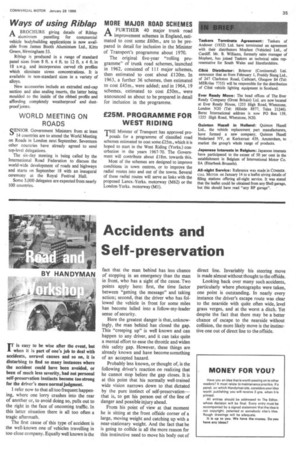Accidents and Self-preservation
Page 37

If you've noticed an error in this article please click here to report it so we can fix it.
ris easy to be wise after the event, but when it is part of one's job to deal with accidents, unravel causes and so on, it is disturbing to find so many instances where the accident could have been avoided, or been of much less severity, had not personal self-preservation instincts become too strong for the driver's more normal judgment.
I refer now to that all too frequent happening, where one lorry crashes into the rear of another or, to avoid doing so, pulls out to the right in the face of oncoming traffic. In this latter situation there is all too often a tragic aftermath.
The first cause of this type of accident is the well-known one of vehicles travelling in too close company. Equally well known is the fact that the man behind has less chance of stopping in an emergency than the man in front, who has a sight of the cause. Two points apply here: first, the time factor between "getting the message" and taking action; second, that the driver who has followed the vehicle in front for some miles has become lulled into a follow-my-leader sense of security.
Here the greatest danger is that, unknowingly, the man behind has closed the gap. This "creeping up" is well known and can happen to any driver, and it can take quite a mental effort to ease the throttle and widen this safety gap. However, these things are already known and have become something of an accepted hazard.
Probably less known, or thought of, is the following driver's reaction on realizing that he cannot stop before the gap closes. It is at this point that his normally well-trained wide vision narrows down to that dictated by the pure instinct of self-preservation— that is, to get his person out of the line of danger and possible injury ahead.
From his point of view at that moment he is sitting at the front offside corner of a large, moving weight and catching up with a near-stationary weight. And the fact that he is going to collide is all the more reason for this instinctive need to move his body out of direct line. Invariably his steering move is made almost without thought to the offside.
Looking back over many such accidents, particularly where photographs were taken, one point is outstanding. In nearly every instance the driver's escape route was clear to the nearside with quite often wide, level grass verges, and at the worst a ditch. Yet despite the fact that there may be a better chance of escape to the nearside without collision, the more likely move is the instinctive one out of direct line to the offside.












































































































